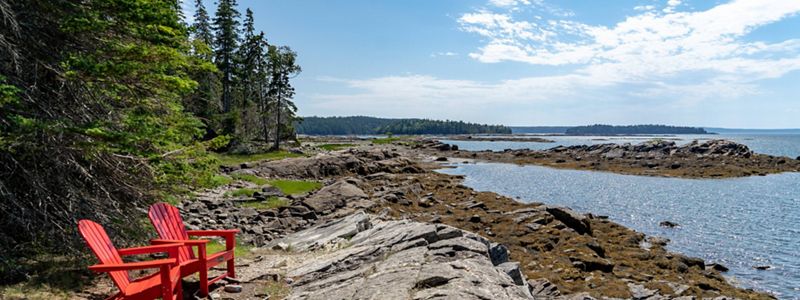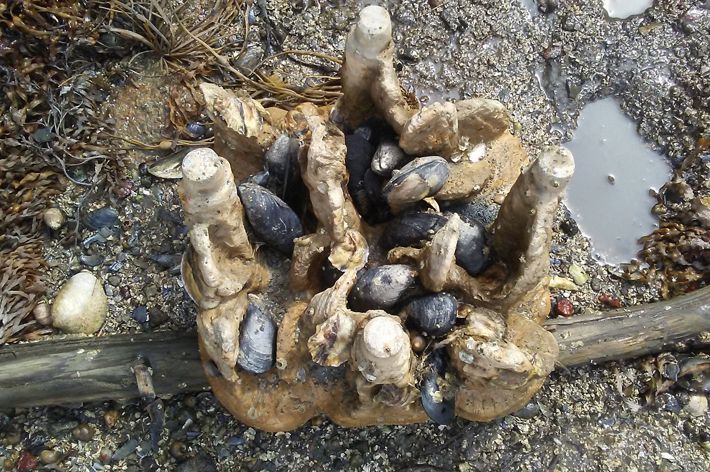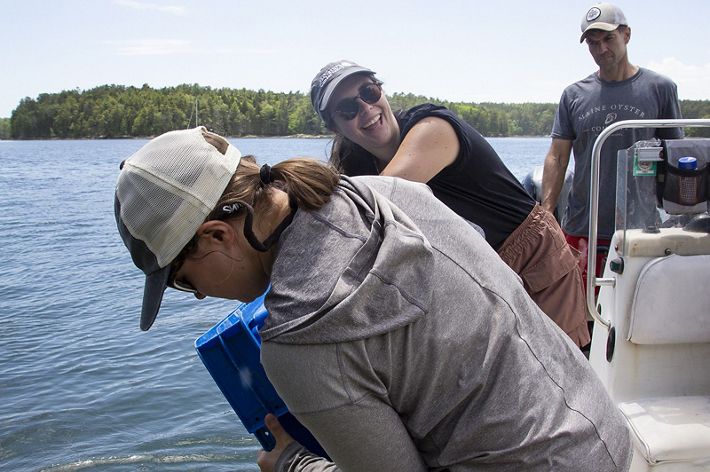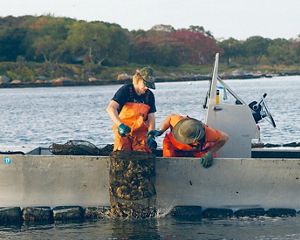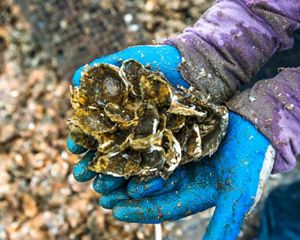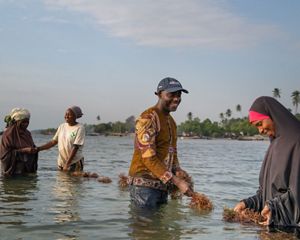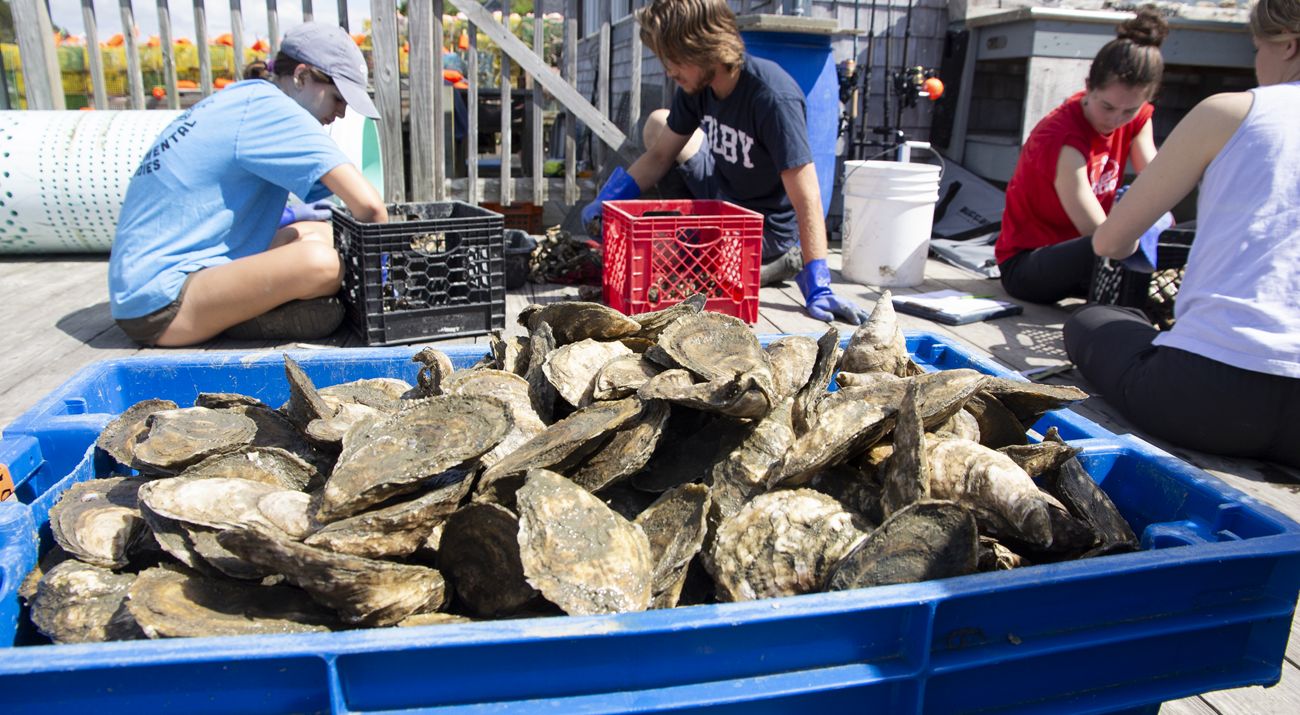
Conservation on the Half Shell
Working with oysters—and oyster growers—to counter the effects of climate change.
On a sunny early summer day, Helena Tatgenhorst pulled a Ford F-150 Lightning electric truck up to a modest cedar-shingled shack perched above Carrying Place Cove in Phippsburg. This was basecamp for the Maine Oyster Company, and Tatgenhorst was here to buy oysters ... sort of.
Soon, more vehicles began arriving and people started to gather. Seven oyster farmers from the New Meadows Co-op brought bags of their own shellfish, and young women and men counted and measured them and placed them in milk crates. You might guess that this bustle of activity was a shellfish market or a festival, but Tatgenhorst is The Nature Conservancy in Maine’s Coastal Nature Based Solutions Strategist, and she was there to support The Basin Oyster Project as they build an oyster reef—an effort that began seven years prior.
In 2017, TNC, in partnership with local and state organizations, launched a project to test oyster and blue mussel reef restoration techniques in the waters just off Basin Preserve in Phippsburg. Project partners set special one-foot by one-foot tiles resembling sandcastles on the seabed. The tiles are designed to mimic the natural environment for young oysters to attach to and grow. As part of the test, some of the tiles had been seeded with very young oysters called spat, along with small, discarded mussels from a nearby aquaculture operation. Additionally, other methods, including setting oyster spat on recycled oyster shells, were tested in the same grid area.
Shellfish and the Environment
Oyster reefs and shellfish beds provide critical habitat for fish, crabs, shrimp and other marine life. They also improve water quality as shellfish filter-feed on phytoplankton and tiny pieces of detritus, removing excess nutrients and suspended particles. The cleaner, clearer water then allows species such as eelgrass to thrive, further improving the health and productivity of the area. Reefs also help stabilize sediments and provide natural shoreline protection as storms become more frequent and powerful. And shellfish are tasty!
For two years, TNC monitored the different species and methods to compare their effectiveness at establishing shellfish beds and reefs. The results were encouraging.
"We were really surprised by how quickly these shellfish grew," says Jeremy Bell, TNC Maine’s Climate Adaptation Program Director. "But we've also learned it's about location, location, location."
Initial siting of the project, chosen with permission from local, state and federal regulators, proved unfavorable to growing a reef. The muddy bottom and slow currents caused the experimental tiles to sink into the sediment—a poor environment for oysters and mussels. A second site, with a harder bottom and stronger currents that sweep the sediment away, was identified, new permits were secured and the tiles moved.
Supporting Shellfish Growers
During that time, a group of seven shellfish growers, led by Bill Mook of Mook Sea Farm in Walpole, Maine, formed a partnership with TNC to create the Shellfish Growers Climate Coalition (SGCC). The coalition's members are dedicated to bringing about climate policy action by sharing their stories of how climate change is already harming their operations, their businesses and their communities. In less than a year, the SGCC grew to over 100 members with operations from Maine to Alaska, welcoming businesses from all food sectors wanting to engage with consumers and policy makers to help chart the country’s course towards a low carbon future.
When COVID-19 hit, and the resulting restaurant closures led to a dramatic decrease in demand for farmed shellfish, TNC and Pew Charitable Trust developed the Supporting Oyster Aquaculture and Restoration (SOAR) program to support a resilient oyster industry and leverage aquaculture in reef restoration—a win-win for these environmentally friendly businesses and for our coastal ecosystems. SOAR includes a Purchase Program as a way to build oyster reefs while also helping shellfish farmers. The program purchases oysters from farms and redirects them to restoration projects, providing an additional income stream for growers and aiding in reef recovery.
A Successful Handoff
In 2019, TNC Maine handed their work in the Basin over to the Basin Oyster Project (BOP) including a Limited Purpose Aquaculture license and $1,000 in funding. A collaboration between the Phippsburg Shellfish Commission, Manomet, Colby College and the Maine Oyster Company, the group has spent the last five years working to build a sustainable oyster reef. With the help of many collaborators and two $20,000 grants, the BOP now has two 40-by-10-foot leases with floating oyster bags that protect the shellfish until they’re large enough to be placed on the seafloor just below. These are supplemented with over-large or “ugly” oysters that growers can’t sell to restaurants. Selling to restoration projects provides additional revenue for the growers and makes an important addition to the reef’s sustainability. This year, the SOAR program is supporting this work through the purchase of 15,000 oysters from New Meadows farmers to be placed on the BOP sites.
Quote: Helena Tatgenhorst
It’s so great to see a community embrace this important work.
Recently, the Maine Community Foundation awarded the project a $190,000 grant to fund the shellfish restoration and research for another two years. The project will use its grant to “explore the social-ecological factors important for siting oyster reef restoration sites.” This includes addressing the concerns of local stakeholders such as wild shellfish harvesters, fishermen and neighbors and ecological research into the viability of different locations for oyster reef building.
“It’s so great to see a community embrace this important work,” says Tatgenhorst. “It’s become a positive study and model for other folks who might want to explore whether it fits their climate planning and action steps.”
Back at basecamp, a large group of students working as part of summer fellowships and internships finish counting, measuring and packing up the oysters. The shellfish are then loaded on to a boat for the trip north along Phippsburg’s western shore to the Basin, where they are unloaded into the depths of the project site.
“On several days this summer, local farmers and fishermen will have the chance to drop off their unwanted oysters to be purchased by TNC and transported to restoration sites,” explains Tatgenhorst. “Shellfish that aren't well-suited for the dinner table just might be perfect for an ocean bed.”
We Can’t Save Nature Without You
Sign up to receive monthly conservation news and updates from Maine. Get a preview of Maine's Nature News email.
